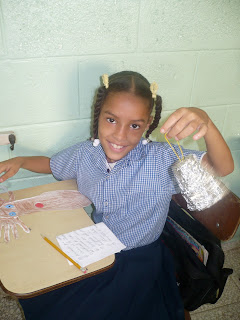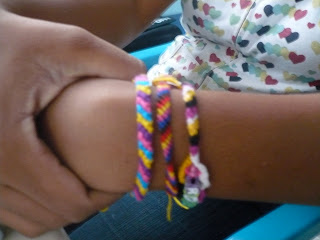On the 7th of October I visited a family for their six-year-old daughter’s birthday party. She ran out to greet me and pointed to the blinking icicle lights hanging from her balcony and said they had just put them up that day. She was so happy to show them off and I told her how beautiful they were. “That’s sweet,” I thought, “that her family put up lights to celebrate her birthday.” During the next few days, though, I started to see more lights on houses. My neighbor’s porch lit up with multi-colored strands wrapped around columns, and an upper balcony down the street started blinking with a colorful array of lights that are brighter and more visually stimulating than the strobe lights at a disco. When the house two blocks away transformed their tropical front yard to a winter wonderland complete with white lights, icicle lighting, two blow-up snowmen, a blow-up Santa, and a blow-up evergreen Christmas tree, I finally figured out what was going on. Christmas comes early here.
 |
| The hand and foot print Reindeer my 4th graders made |
 |
| The hand print Christmas wreath we made in 3rd grade |
The people of Dominican Republic are very religious, mostly Catholic, and they hold fast to tradition. Navidad (Christmas) and La Dia de Los Reyes (Three Kings Day) are important religious celebrations here that arrived with the Spanish Conquistadores. Also, though, Dominican Republic is close to the U.S. and our culture has had a strong impact on the culture here. This combination has created a hybrid-Christmas celebration season that is uniquely Dominican.
 |
| 3rd grade drawing their hands for our wreath |
 |
| Carolina showing off her Jingle Bell |
 |
| Adrian cutting for his Reindeer |
 |
| 4th grade working hard on their Reindeers |
 |
| 3rd grade working on their 3D Trees and Snowmen |
 |
| Junior tracing his foot for his Reindeer |
 |
| 4th graders working hard! |
Just after I figured out what was going on with the lights, I noticed that my friends’ houses were decorated inside with Christmas tablecloths and other decorations. Like at home, these decorations have been increasing as we get close to the holiday. The first Christmas tree I saw inside was around the end of October. They buy fake evergreen trees, completely in the style of the U.S. and some are decorated in our style too, but there are others that are decorated with more traditional Dominican Christmas decorations like huge ribbons and drapes of fabric in bright colors. It is not unusual to see tropical and florescent colors on a tree, and sometimes they are so overly decorated, it is hard to see the tree underneath.
Stores and companies take advantage of the season just like in the U.S., and stores brought out their Christmas merchandise as soon as they put away the school supplies at the end of September. The cell phone companies started Christmas advertisements around the same time, letting us know that what our loved ones really need/want is a new phone and plan that allows them to talk to us and all their friends. The internet companies, grocery stores, and furniture stores weren’t far behind, and now they are all advertising the perfect gifts and their store fronts are complete with red and green decorations.
 |
| My neighbors' Christmas Tree |
In mid-October the television channels started to celebrate with Christmas songs by famous Dominican singers airing during lulls in the programming and Christmas ideas and discussions on talk shows, cooking shows, and news programs. I have to say it was a bit jarring the first time I heard “Santa Claus is Coming to Town” being sung in Spanish on my TV while I was sweating in 90 degree heat, wearing a tank top and shorts.
 |
| My Christmas Tree |
I’ve now joined the holiday spirit though, and I have bought a small Christmas tree for myself that I’ve decorated with blinking colored lights and some gold star garland. There is also a gold star on the top and I got mittens that say, “Feliz Navidad” to hang on it. I also have blinking lights on my front door and a snowman welcoming everyone who comes to visit. I play my favorite Christmas songs on my computer and IPod at home and in my classes and I’m going to look into getting some of the more popular Spanish Christmas Carols and my classes have been full of fun Christmas activities.
 |
4th grade showing of the Jingle Bells we made
to play while we sing the song |
I won’t be here for Christmas. I’m coming home to Boxford on Tuesday for 2 weeks to celebrate the holiday with my family, but from what my friends have said, I won’t actually miss too much. Noche Buena (Christmas Eve) is a family holiday. Extended families come together to eat traditional Dominican Christmas food like Biscocho con Pasas (Cake with raisins) and Pasteles en Hojas (a tamale made with yucca and plantain filled with meat and spices and wrapped in a banana leaf). I was also told by some of my friends that there has to be pork. They said that if there isn’t pork, it doesn’t feel like Noche Buena, and that you can tell how good a year your family has had based on the amount of pork served. It is a night of eating and visiting family, much like our Thanksgiving celebrations. On Christmas Day, families relax and go to church. They say that they eat leftovers from Noche Buena and take it easy. It is a very low-key day. My celebration at home will be more of event than Christmas here.
I’ll be back in Dominican Republic in time for the real celebrations. After the large parties and celebrations of New Years Eve and New Years Day, the Dominicans get ready for their big holiday celebration. Their version of our American Christmas comes at Epiphany. In Christian tradition, Epiphany is the day that the Three Magi arrive to bring the baby Jesus his gifts. Spanish kids are given gifts not by Santa Claus, but by the Three Kings. On January 5th, the night before La Dia de Los Reyes, families get together again, sometimes exchanging some early gifts and preparing for the next day. Kids leave grass for the King’s camels and mints or candies for the Kings to eat before going to sleep early because they know that the Kings won’t bring them their presents until they are tucked in their beds fast asleep. The more traditional custom is for the Kings to leave the presents under the children’s beds, sometimes in shoes or shoe boxes, but the American tradition of presents under the Christmas tree has been adapted by many families. American culture has also influenced the amount of presents, and families demonstrate their wealth with the size of the pile of presents they give their kids.
 |
| Sister Priscilla teaching the Centro Buen Pastor kids about Advent |
The middle-class and upper-class Dominicans have a Dia de Los Reyes that is very similar to our Christmas day. After opening gifts in the morning, some families go to church, and others meet with extended family for meals and more celebrations. There is more traditional food and festivities. Often, wealthier families and companies will distribute gifts to the poor. For many years there was a rich benefactor who supplied huge amounts of goods ranging in value from bags of rice and chickens to new refrigerators and stoves that were given out to people who got “tickets” which were distributed to the first few hundred people in line. Each person with a ticket was entered into the drawing and given the “prize” that matched the number on their ticket. The drawing was completely random and from what I can tell it would have been a crazy event, but very exciting and wonderful to the poor people who received the goods. When the benefactor passed away, though, the event stopped and there isn’t anything like it today.
 |
| The Advent Wreath at Centro Buen Pastor |
 |
| Sister Priscilla with the younger kids at church |
Not every family can have an American or Spanish style holiday celebration though. I asked one of my students, who’s financial situation is so difficult that he had to ask for a scholarship to pay the $3 a month that my English class costs, about his Christmas plans. He said that if he’s lucky, he’ll get to visit his mom that day (he lives with his grandmother) and she has a TV, so he’ll get to watch TV all day. I asked him about special food and celebrations, and he said there wouldn’t be anything special. He said that sometimes he gets a present on Dia de los Reyes, but not always, and they don’t do anything special that day either. It was hard for me to hear such an obvious difference between his answer and the answer of my friends who had gone on and on about the traditions that they practice in their families for these important holidays.
I’m looking forward to both my American Christmas and my first experience of Dominican Dia de Los Reyes. I also will have my student and all those others whose families cannot afford to celebrate in my mind during my festivities. My greatest Christmas wish is that, with the positive support and influences that this student and the other kids at Centro Buen Pastor are getting from the mission of the Sisters of the Transfiguration and our support, when they grow up, they will be able to get good jobs and be able to afford to celebrate with their families.
Feliz Navidad y Feliz Dia de los Reyes!



















































